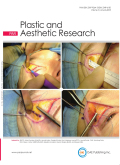- 钛学术文献服务平台 \
- 学术期刊 \
- 医药卫生期刊 \
- 外科学期刊 \
- 整形与美容研究(英文版)期刊 \
Facial morphospace: a clinical quantitative analysis of the three-dimensional face in patients with cleft lip and palate
Facial morphospace: a clinical quantitative analysis of the three-dimensional face in patients with cleft lip and palate
基本信息来源于合作网站,原文需代理用户跳转至来源网站获取
摘要:
Aim: The aims were: (1) to examine the clinical application of a geometric morphometric method (GMM) that quantifies the three-dimensional (3D) configuration of the facial soft tissues in patients with a repaired unilateral cleft lip and palate (UCLP); and (2) to determine the morphological characteristics that distinguish between non-cleft participants and patients with UCLP.Methods: 3D facial images at rest were recorded from Japanese patients with a repaired UCLP (Cleft group; n = 60) and healthy adults featuring a straight type facial profile with normal occlusion (Control group; n = 200) using 3D photogrammetric cameras. For each participant, wire mesh fitting was conducted based on the assignment of landmarks to each 3D facial image. This method generated landmark-based GMM models consisting of 6017 nodes on the fitted wire mesh. For each node, the mean and standard deviation were determined in the Control group and were used as the normative range of the faces. With this normative range, the Z-scores before and after surgery were evaluated for patients with UCLP who underwent orthognathic bimaxillary surgery. Further, the morphological characteristics of the Cleft group were evaluated using a principal component (PC) regression analysis that distinguished between two subject groups. In addition, K-means clustering analysis and MANOVA were used to examine the morphological variation of the Cleft group. Results: A patient with UCLP was evaluated with the system. After surgery, the normal area increased by 8%-20% on all axes, which means that the surgery was effective for normalizing the patient's face. However, even after surgery, the protrusion of the lower lip and asymmetry remained. Nine PCs were extracted, and seven PCs were selected for the regression model to discriminate two subject groups, e.g., midfacial retrusion, nasal bump, and chin protrusion. The MANOVA also revealed significant differences between both the Cleft and Control groups and the sex subgroups, and the effects of cleft on the facial morphology was found to be related to sex (all, P < 0.01).Conclusion: The clinical application of GMM was confirmed to be effective. GMM detected variations of the Cleft group and morphological characteristics. GMM is considered to be a powerful tool to quantitatively evaluate faces in clinics.

推荐文章
FACE水稻生育期模拟
水稻
FACE
生育期
模拟模型
Groundwater quality assessment using multivariate analysis, geostatistical modeling, and water quali
Groundwater
Multivariate analysis
Geostatistical modeling
Geochemical modeling
Mineralization
Ordinary Kriging
Hydrogeochemical processes and multivariate analysis for groundwater quality in the arid Maadher reg
Groundwater quality
Hydrogeochemical processes
Multivariate analysis
Salinity
Mio-Plio
Quaternary aquifer
FACE水稻氮素动态的模拟研究
水稻
FACE
N素累积量
植株含N率
模拟模型
内容分析
关键词云
关键词热度
相关文献总数
(/次)
(/年)
文献信息
| 篇名 | Facial morphospace: a clinical quantitative analysis of the three-dimensional face in patients with cleft lip and palate | ||
| 来源期刊 | 整形与美容研究(英文版) | 学科 | |
| 关键词 | |||
| 年,卷(期) | 2020,(9) | 所属期刊栏目 | Original Article |
| 研究方向 | 页码范围 | 18-33 | |
| 页数 | 16页 | 分类号 | |
| 字数 | 语种 | 英文 | |
| DOI | 10.20517/2347-9264.2020.136 | ||
五维指标
引文网络
引文网络
二级参考文献 (0)
共引文献 (0)
参考文献 (26)
节点文献
引证文献 (0)
同被引文献 (0)
二级引证文献 (0)
1984(1)
- 参考文献(1)
- 二级参考文献(0)
1993(1)
- 参考文献(1)
- 二级参考文献(0)
1995(1)
- 参考文献(1)
- 二级参考文献(0)
1997(1)
- 参考文献(1)
- 二级参考文献(0)
1999(1)
- 参考文献(1)
- 二级参考文献(0)
2001(1)
- 参考文献(1)
- 二级参考文献(0)
2002(1)
- 参考文献(1)
- 二级参考文献(0)
2003(2)
- 参考文献(2)
- 二级参考文献(0)
2005(1)
- 参考文献(1)
- 二级参考文献(0)
2006(2)
- 参考文献(2)
- 二级参考文献(0)
2007(2)
- 参考文献(2)
- 二级参考文献(0)
2008(1)
- 参考文献(1)
- 二级参考文献(0)
2009(1)
- 参考文献(1)
- 二级参考文献(0)
2010(2)
- 参考文献(2)
- 二级参考文献(0)
2011(3)
- 参考文献(3)
- 二级参考文献(0)
2015(1)
- 参考文献(1)
- 二级参考文献(0)
2016(1)
- 参考文献(1)
- 二级参考文献(0)
2017(1)
- 参考文献(1)
- 二级参考文献(0)
2018(1)
- 参考文献(1)
- 二级参考文献(0)
2019(1)
- 参考文献(1)
- 二级参考文献(0)
2020(0)
- 参考文献(0)
- 二级参考文献(0)
- 引证文献(0)
- 二级引证文献(0)
引文网络交叉学科
相关学者/机构
期刊影响力
整形与美容研究(英文版)
主办单位:
出版周期:
月刊
ISSN:
2347-9264
CN:
开本:
出版地:
陕西省西安市高新区绿地SOHO B座1705室
邮发代号:
创刊时间:
语种:
eng
出版文献量(篇)
440
总下载数(次)
0
总被引数(次)
32
期刊文献
相关文献
推荐文献
- 期刊分类
- 期刊(年)
- 期刊(期)
- 期刊推荐
整形与美容研究(英文版)2022
整形与美容研究(英文版)2021
整形与美容研究(英文版)2020
整形与美容研究(英文版)2019
整形与美容研究(英文版)2018
整形与美容研究(英文版)2017
整形与美容研究(英文版)2016
整形与美容研究(英文版)2015
整形与美容研究(英文版)2014
整形与美容研究(英文版)2020年第9期
整形与美容研究(英文版)2020年第8期
整形与美容研究(英文版)2020年第7期
整形与美容研究(英文版)2020年第6期
整形与美容研究(英文版)2020年第5期
整形与美容研究(英文版)2020年第4期
整形与美容研究(英文版)2020年第3期
整形与美容研究(英文版)2020年第2期
整形与美容研究(英文版)2020年第12期
整形与美容研究(英文版)2020年第11期
整形与美容研究(英文版)2020年第10期
整形与美容研究(英文版)2020年第1期

 免费查重
免费查重










